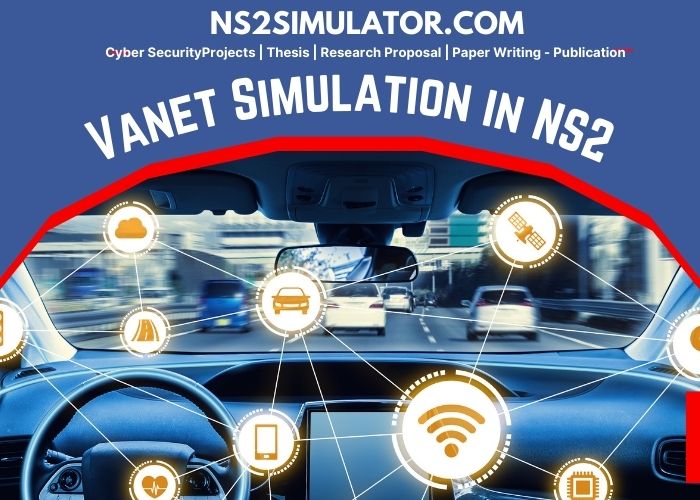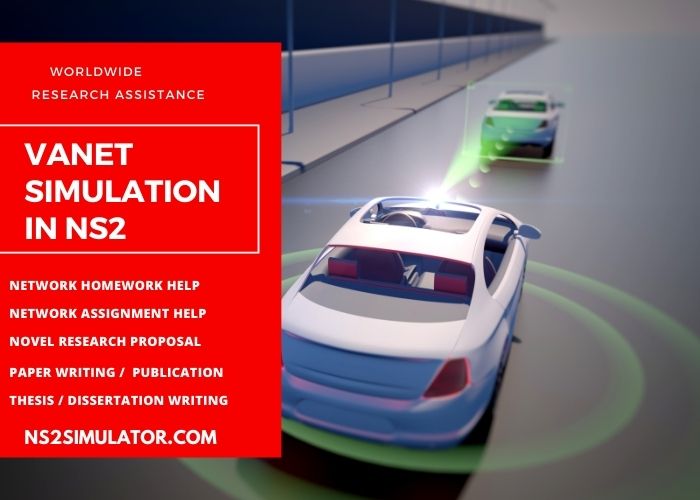Vehicular Ad hoc Networks (VANET) constructs the spontaneous ad hoc network over vehicles moving on the highway. Vanet is a fast emerging research area for developing and deploying new and old-fashioned applications. Moreover, Vanet Simulation in NS2 is regarded as great mobility, fast dynamic topology, and ephemeral, one-time interactions.
Read onto this page to be acquainted with the latest research challenges and solutions of VANET Simulation in NS2 !!!
Essentially, both VANETs and MANET are described in terms of node’s movement and self-organization (For instance: vehicles in the case of VANET). And the VANETs features may vary from MANET due to driver behaviour and the high speed of the vehicle. However, VANETs are rapidly characterized but rather than followings,
- Predictable Topology Changes
- Frequent Fragmentation
- Small Effective Network Diameter
- Redundancy
How does VANET Simulation in NS2 works?
As we all known earlier, VANETs is the subcategory of traditional Mobile Ad hoc Networks (MANETs). Here, the mobile nodes are vehicles capable of sophisticated “on-board” equipment for data exchange through communication protocols. And, it travels on constrained paths (i.e., roads and lanes) which support communication between vehicles and fixed road-side access points.
What are the important issues in VANET?
In comparison with MANETs, VANETs features need diverse communication paradigms, approaches for secure and private wireless communication systems. For instance, network connections are unstable for a long period. The researchers have explored the efficient use of available infrastructure to expand the performance of communication. Even though some particular encounters of VANETs have not been solved yet. Hence, our research team is currently doing deeper work to solve this vanet simulation in NS2 challenges. Here, we have discussed and summarized some of the key challenges.
Key Challenges in Designing Vanet Simulation
- Network Connectivity
- In addition, designing the network with good delay performance in spite of certain below limitations is also a big problem,
- Vehicle Speed
- High Dynamic Topology
- Channel Bandwidth
- The first and foremost challenge in VANET is network connection management which takes place within vehicles or network
- In addition, designing the network with good delay performance in spite of certain below limitations is also a big problem,
- Routing Protocols
- Still, the following approaches are considered as the crucial challenge to design efficient routing protocols,
- GyTAR (Greedy Traffic-Aware Routing)
- CMV (Cognitive MAC for VANET)
- Even though researchers are designing various operative routing protocols and algorithms, the attainment of high vehicles mobility and high dynamic topology is quite difficult task.
- Still, the following approaches are considered as the crucial challenge to design efficient routing protocols,
- Security and Privacy
- For instance, in the case of key distribution there exist several challenges, such as violating driver privacy in various industrial companies.
- In efficiency requirement, the exchange of the security and privacy has grown into the biggest challenge.
- Still, there are several noteworthy shortcomings and solutions rely on “key pair / certificate / signature.”
- Cooperative Communication
- Hence, the collaboration of these frameworks has turn into a vital challenge
- VANETs is a subclass of mobile computing cloud (MCC) whereas it is a wideband cloud in vehicular networks
- Cross-Layer Design
- Here, the cross-layer protocols are used to offer priorities over diverse flows and applications
- At present, designing the cross-layer between original layers has become single solution to support real-time and multimedia applications
- IEEE Standards
- Huge vehicles are not smartly constructed by existing MAC parameters of the IEEE 802.11p protocol
- Hence, researchers are currently focusing more on these standards.
- The requirement of robust network connectivity is not achieved by the original IEEE 802.11 standard
- Mobility
- Hence, the mobility is used to design and model vehicular protocol
- Mobility makes the topology to change dynamically and rapidly in vehicular networks. Also, the vehicles mobility patterns reveals the robust correlations
Further, if you want to know more about our Vanet Simulation in NS2 service, then tie-up with us for getting more research ideas in VANET. For your information, here we shared few important research ideas hand-picked by our experts.
Top 9 Vanet Research Areas
- Mobile Ad-hoc and Vehicular Networks
- Inter-Vehicular and Intra-Vehicular Networks
- Vehicle to Cloud or Everything Networks
- Vehicular Grid and Cloud Communication
- Limitations and Challenges of VANET
- MANET Mobile Ad Hoc Network
- IoV – Big Data Challenges for Connected Vehicles
- VANET based Information Security and Management
- Vehicle-to-Infrastructure and Vehicle-to-Vehicle Communication
- Safety of Highway / Automobile / Passenger / Pedestrian in Intelligent Transportation
In the following, we have given you two sample Vanet research topics in detail.
Research Topics in VANET Vehicular Ad Hoc Network
- Queue Management under High Network Density – If a safety message runs into a void and the network is poorly disconnected; the relay vehicle upkeep the data packet till the relay finds the new optimal vehicle. However, the vehicle carrying packet for one source can also hold and carry data packets of other sources by creating a queue. In such cases, the local optimum problem is greedier by examining all the packet copies which are close to the expiration deadline. Furthermore, the data packet which has higher priority is taken as relay first from all other packets. Then the intelligent technique can handle void more optimally based on appropriate message scheduling. And also, management of queues is also very important when there is restricted bandwidth and buffer space.
- Complex Real-time Traffic Management – As a matter of fact in the case of urban scenarios, it is vital to analyze the obstacles influence and road obstructions to get a wide-ranging view of VANET topology.
Our VANET Simulation in NS2 service has been launched with an aim to simulate VANET with both open source and commercial simulators. Through this, we can analyze the network effect on wireless communication but to execute this work a good simulator is required. Hence, we are discussing the current simulators to get the best simulation results apart from NS2 simulator.

VANET Simulation in NS2 Working Model?
Simulation is the most essential step before incorporating the new technologies in VANETs. Here, the VANET simulation utilizes two dissimilar components as a traffic simulator and a network simulator
- Traffic Simulators – It generates single vehicle’s position and movement information to analyze network characteristics and protocol performances in VANETs environs.
- SUMO – Simulation of urban mobility
- VISSIM – Simulation of the vehicles position and movement with city and highway traffic
- Network Simulators – In this, functionalities of VANETs can be designed and analyzed. And, the good network simulator should meet the following features,
- Comprehensive Mode
- Communication Technologies like IEEE 1609 and IEEE 802.11[p]
- Operative Protocol for Routing like AODV
If you are looking for the Implementing Vanet Simulation in NS2, then contact us. Our experts will guide you to reach your research destination in spite of any kind of research idea.

